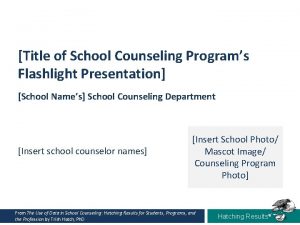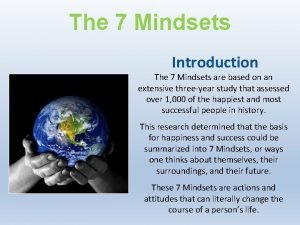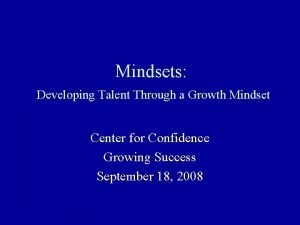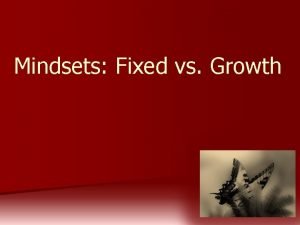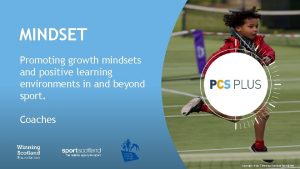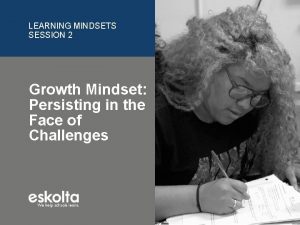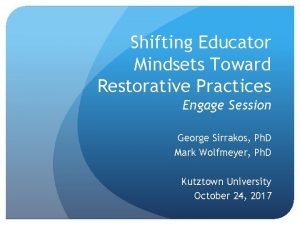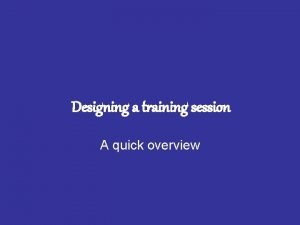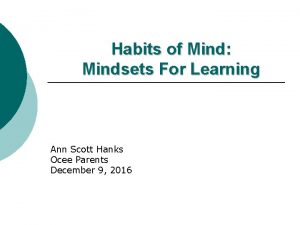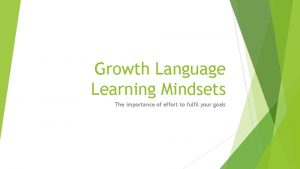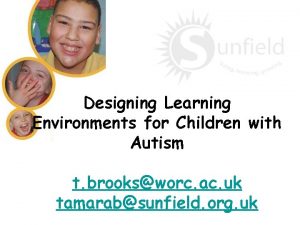LEARNING MINDSETS SESSION 5 Designing Learning Environments That















- Slides: 15

LEARNING MINDSETS SESSION 5 Designing Learning Environments That Cultivate Positive Mindsets

Designing Learning Environments That Cultivate Positive Mindsets “Kids don’t learn when they don’t feel safe or valued. ” KYLE SCHWARTZ, third-grade teacher

Designing Learning Environments That Cultivate Positive Mindsets Objectives: 1. Identify structures in a learning environment that can support students’ mindsets 2. Develop a plan for using one targeted change in the learning environment to support student development of learning mindsets 3

Designing Learning Environments That Cultivate Positive Mindsets Review the Three Mindsets: As you review the key aspects of each of the three learning mindsets, note any students who immediately come to mind as either demonstrating or struggling with these mindsets. 4

5 Designing Learning Environments That Cultivate Positive Mindsets Three Learning Mindsets for Perseverance To persist in hard work, students need to learn from setbacks, believe that effort will pay off, and have a sense of belonging and ownership over their own learning. #1 Growth Mindset #2 Sense of Belonging #3 Value for Learning 5

Designing Learning Environments That Cultivate Positive Mindsets Growth Mindset “My effort leads to growth” ▪ Students believe that intelligence is malleable and that their brain can grow ▪ Students think that practice and effort can help them get better ▪ Students believe that mistakes are normal and a valuable part of learning 6

Designing Learning Environments That Cultivate Positive Mindsets Belonging Mindset “I belong here” ▪ Students have trusting relationships ▪ Students feel respected in their school community ▪ Students feel that their unique voice matters in the school ▪ Students’ sense of identity includes being a learner in this school community ▪ Students do not wonder whether they belong in school (i. e. , absence of belonging uncertainty or stereotype threat) 7

Designing Learning Environments That Cultivate Positive Mindsets Value Mindset “This work has value to me” ▪ Students have intrinsic interest in what they are learning ▪ Students see the real-world utility of what they’re learning ▪ Students see purposeful, personal connections to what they are learning ▪ Students feel a sense of autonomy, choice, and ownership over their learning 8

Designing Learning Environments That Cultivate Positive Mindsets Reflect on Student Needs: ▪ As you listen to the example, think about the ways that your school in general, and you personally, create materials and a classroom environment that provide opportunities for students to develop positive mindsets. 9

Designing Learning Environments That Cultivate Positive Mindsets Identify a Mindset Focus: ▪ Thinking about your own students, individually complete Steps A and B of the Learning Environments Planner and select one learning mindset to focus on. 10

Designing Learning Environments That Cultivate Positive Mindsets Explore Starter Kits: Form three groups—one for each of the mindsets. In your group: ▪ Review the catalog of starter kit options in the Learning Mindsets Starter Kits. ▪ Choose one to explore together as a group. ▪ How might you use this or something like it at your school? ▪ What adaptations might you make? ▪ What other ideas does this give you for ways to cultivate this mindset? 11

Designing Learning Environments That Cultivate Positive Mindsets Individually Plan: ▪ Take the ideas that arose from working with your mindset group. ▪ Work further on adapting ideas from this Starter Kit for your own context or pick a different one and complete Step D of the Learning Environments Planner. 12

Designing Learning Environments That Cultivate Positive Mindsets Share in Pairs: ▪ ▪ With a partner, share implementation plans. Ask questions and share any additional ideas. 13

Designing Learning Environments That Cultivate Positive Mindsets Learning Wrap-Up ▪ ▪ Reflect on what you learned today. How do your takeaways compare to the session’s Learning Objectives? How were these objectives addressed today? LEARNING OBJECTIVES: 1. Identify structures in a learning environment that can support students’ learning mindsets 2. Develop a plan for using one targeted change in the learning environment to support student development of learning mindsets 14

Designing Learning Environments That Cultivate Positive Mindsets What’s next? ▪ Learn more about strategies that promote academic mindsets ▪ Understand the mindsets students need to be academically successful ▪ Understand the impact of learning mindsets on students’ experiences in school ▪ Learn more about how to create a classroom culture that builds on students’ strengths 15
 Jonassen constructivist learning environment
Jonassen constructivist learning environment False growth mindset
False growth mindset Asca mindsets and behaviors chart
Asca mindsets and behaviors chart Asca mindsets and behaviors
Asca mindsets and behaviors Asca mindsets and behaviors
Asca mindsets and behaviors Mays transformational leader mindsets
Mays transformational leader mindsets What are the 7 mindsets
What are the 7 mindsets Mindsets: developing talent through a growth mindset
Mindsets: developing talent through a growth mindset Types of mindsets
Types of mindsets 7 mindsets academy
7 mindsets academy Phân độ lown
Phân độ lown Block nhĩ thất độ 1
Block nhĩ thất độ 1 Thể thơ truyền thống
Thể thơ truyền thống Thơ thất ngôn tứ tuyệt đường luật
Thơ thất ngôn tứ tuyệt đường luật Walmart thất bại ở nhật
Walmart thất bại ở nhật Tìm vết của đường thẳng
Tìm vết của đường thẳng


